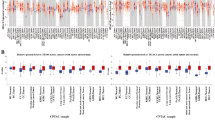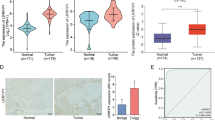Abstract
To investigate the impact of histone methyltransferase enhancer of zeste homolog 2 (EZH2) on the proliferation and apoptosis of human cholangiocarcinoma cells as well as its related mechanisms. Immunohistochemistry and Western blot analyses were used to examine the expression of EZH2 in 40 cases of human cholangiocarcinoma tissues and four strains of human cholangiocarcinoma cells. The influence of EZH2 on cell growth and apoptosis were assessed by knockdown experiments, and a xenograft experiment in nude mice was performed to evaluate the impact of siEZH2 on the tumorigenicity of tumor cells. The correlation of EZH2, clinic pathological features and overall survival rates was also analyzed. EZH2 was highly expressed in human cholangiocarcinoma tissues and cells. Silencing of EZH2 could significantly reduce the methylation level of RUNX3 DNA in human cholangiocarcinoma cells and improve its protein expression as well as inhibit cell proliferation, induce apoptosis and slow down the growth of tumor in nude mice. In addition, the expression of EZH2 was associated with the tumor stage, lymph node positivity and poor prognoses. Overexpression of EZH2 can promote the proliferation of cholangiocarcinoma cells and inhibit their apoptosis. It is associated with poor prognoses in patients with cholangiocarcinoma. Therefore, EZH2 could be a potential clinical therapeutic target for the treatment of cholangiocarcinoma.








Similar content being viewed by others
References
Alpini G, McGill JM, Larusso NF. The pathobiology of biliary epithelia. Hepatology. 2002;35:1256–68.
Khan SA, Thomas HC, Davidson BR, Taylor-Robinson SD. Cholangiocarcinoma. Lancet. 2005;366:1303–14.
Shaib YH, El-Serag HB, Nooka AK, Thomas M, Brown TD, Patt YZ, Hassan MM. Risk factors for intrahepatic and extra-hepatic cholangiocarcinoma: a hospital-based case-control study. Am J Gastroenterol. 2007;102:1016–21.
Albores-Saavedra J, Murakata L, Krueger JE, Henson DE. Noninvasive and minimally invasive papillary carcinomas of the extrahepatic bile ducts. Cancer. 2000;89:508–15.
Gatto M, Alvaro D. New insights on cholangiocarcinoma. World J Gastrointest Oncol. 2010;2:136–45.
Leelawat K, Narong S, Wannaprasert J, Ratanashu-ek T. Prospective study of MMP7 serum levels in the diagnosis of cholangiocarcinoma. World J Gastroenterol. 2010;16:4697–703.
Seehofer D, Kamphues C, Neuhaus P. Management of bile duct tumors. Expert Opin Pharmacother. 2008;9:2843–56.
Schuettengruber B, Ganapathi M, Leblanc B, Portoso M, Jaschek R, Tolhuis B, van Lohuizen M, Tanay A, Cavalli G. Functional anatomy of polycomb and trithorax chromatin landscapes in Drosophila embryos. PLoS Biol. 2009;7:e13.
Cao R, Wang L, Wang H, Xia L, Erdjument-Bromage H, Tempst P, Jones RS, Zhang Y. Role of histone H3 lysine 27 methylation in Polycomb-group silencing. Science. 2002;298:1039–43.
Simon JA, Lange CA. Roles of the EZH2 histone methyltransferase in cancer epigenetics. Mutat Res. 2008;647:21–9.
Varambally S, Dhanasekaran SM, Zhou M, Barrette TR, Kumar- Sinha C, Sanda MG, Ghosh D, Pienta KJ, Sewalt RG, Otte AP, Rubin MA, Chinnaiyan AM. The polycomb group protein EZH2 is involved in progression of prostate cancer. Nature. 2002; 419:624–9.
Kleer CG., Cao Q, Varambally S, Shen R, Ota I, Tomlins SA, Ghosh D, Sewalt R G, Otte AP, Hayes DF, Sabel MS, Livant D, Weiss SJ, Rubin MA and Chinnaiyan AM. EZH2 is a marker of aggressive breast cancer and promotes neoplastic transformation of breast epithelial cells. Proc Natl Acad Sci USA. 2003; 100:11606–11.
Bachmann IM, Halvorsen OJ, Collett K, Stefansson IMM, Straume O, Haukaas SA, Salvesen HB, Otte AP, Akslen LA. EZH2 expression is associated with high proliferation rate and aggressive tumor subgroups in cutaneous melanoma and cancers of the endometrium, prostate, and breast. J Clin Oncol. 2006;24:268–73.
Guo J, Cai J, Yu L, Tang H, Chen C, Wang Z. EZH2 regulates expression of p57 and contributes to progression of ovarian cancer in vitro and in vivo. Cancer Sci. 2011;102:530–9.
Nakagawa S, Okabe H, Sakamoto Y, Hayashi H, Hashimoto D, Yokoyama N, Sakamoto K, Kuroki H, Mima K, Nitta H, Imai K, Chikamoto A, Watanabe M, Beppu T, Baba H. Enhancer of zeste homolog 2 (EZH2) promotes progression of cholangiocarcinoma cells by regulating cell cycle and apoptosis. Ann Surg Oncol. 2013; 20 Suppl 3:S667–75.
Okuda T, van Deursen J, Hiebert SW, Grosveld G, Downing JR. AML1, the target of multiple chromosomal translocations in human leukemia, is essential for normal fetal liver hematopoiesis. Cell. 1996;84:321–30.
Woolf E, Xiao C, Fainaru O, Lotem J, Rosen D, Negreanu V, Bernstein Y, Goldenberg D, Brenner O, Berke G, Levanon D, Groner Y. Runx3 and Runx1 are required for CD8 T cell development during thymopoiesis. Proc Natl Acad Sci USA. 2003;100:7731–6.
Chi XZ, Yang JO, Lee KY, Ito K. Sakakura C, Li QL, Kim HR, Cha EJ, Lee YH, Kaneda A, Ushijima T, Kim WJ, Ito Y, and Bae SC. RUNX3 suppresses gastric epithelial cell growth by inducing p21(WAF1/Cip1) expression in cooperation with transforming growth factor {beta}-activated SMAD. Mol Cell Biol. 2005; 25:8097–107.
Yano T, Ito K, Fukamachi H, Chi XZ, Wee HJ, Inoue K, Ida H, Bouillet P, Strasser A, Bae SC, Ito Y. The RUNX3 tumor suppressor upregulates Bim in gastric epithelial cells undergoing transforming growth factor beta-induced apoptosis. Mol Cell Biol. 2006;26:4474–88.
Xiao WH, Liu WW. Hemizygous deletion and hypermethylation of RUNX3 gene in hepatocellular carcinoma. World J Gastroenterol. 2004;10:376–80.
Kang GH, Lee S, Lee HJ, Hwang KS. Aberrant CpG island hypermethylation of multiple genes in prostate cancer and prostatic intraepithelial neoplasia. J Pathol. 2004;202:233–40.
Li QL, Kim HR, Kim WJ, Choi JK, Lee YH, Kim HM, Li LS, Kim H, Chang J, Ito Y, Youl Lee K, and Bae SC. Transcriptional silencing of the RUNX3 gene by CpG hypermethylation is associated with lung cancer. Biochem Biophys Res Commun. 2004; 314: 223–8.
Shin SH, Lee K, Kim BH, Cho NY, Jang JY, Kim YT, Kim D, Jang JJ, Kang GH. Bile-based detection of extrahepatic cholangiocarcinoma with quantitative DNA methylation markers and its high sensitivity. J Mol Diagn. 2012;14:256–63.
Tan JZ, Yan Y, Wang XX, Jiang Y, Xu HE. EZH2 biology, disease, and structure-based drug discovery. Acta Pharmacol Sin. 2014;35:161–74.
Sasaki M, Yamaguchi J, Itatsu K, Ikeda H, Nakanuma Y. Overexpression of polycomb group protein EZH2 relates to decreased expression of p16 INK4a in cholangiocarcinogenesis in hepatolithiasis. J Pathol. 2008;215:175–83.
Chuang LS, Ito K, Ito Y. RUNX family: regulation and diversification of roles through interacting proteins. Int J Cancer. 2013;132:1260–71.
McGarvey KM, Fahmer JA, Greene E, Martens J, Jenuwein T, Baylin SB. Silenced tumor suppressor genes reactivated by DNA demethylation do not return to a folly euchromatic chromatin state. Cancer Res. 2006; 663541–9.
Wang C, Liu Z, Woo CW, Li Z, Wang L, Wei JS, Marquez VE, Bates SE, Jin Q, Khan J, Ge K, Thiele CJ. EZH2 mediates epigenetic silencing of neuroblastoma suppressor genes CASZ1, CLU, RUNX3, and NGFR. Cancer Res. 2012;72:315–24.
Zhang B, Liu XX, He JR, Zhou CX, Guo M, He M, Li MF, Chen GQ, Zhao Q. Pathologically decreased miR-26a antagonizes apoptosis and facilitates carcinogenesis by targeting MTDH and EZH2 in breast cancer. Carcinogenesis. 2011;32:2–9.
Ougolkov AV, Bilim VN, Billadeau DD. Regulation of pancreatic tumor cell proliferation and chemoresistance by the histone methyltransferase enhancer of zeste homologue 2. Clin Cancer Res. 2008;14:6790–6.
Goldstraw P, Crowley J, Chansky K, Giroux DJ, Groome PA, Rami-Porta R, Postmus PE, Rusch V, Sobin L. The IASLC Lung Cancer Staging Project: proposals for the revision of the TNM stage groupings in the forthcoming (seventh) edition of the TNM classification of malignant tumours. J Thorac Oncol. 2007;2:706–14.
Viré E, Brenner C, Deplus R, Blanchon L, Fraga M, Didelot C, Morey L, Van Eynde A, Bernard D, Vanderwinden JM, Bollen M, Esteller M, Di Croce L, de Launoit Y, Fuks F. The polycomb group protein EZH2 directly controls DNA methylation. Nature. 2006;439:871–4.
Acknowledgments
This research was supported in part by the National Natural Science Foundation of China (Nos. 81360367, 81160066 and 30870719), Key Project of Science and Technology for Colleges and Universities in Guangxi (2013ZD046), Pharmaceutical Technology Special Project of the Health Department in Guangxi (GZPT13-45), Open Fund Project of Key Laboratory of Molecular Medicine in Liver Damage and Repair, Guangxi (QT2013025), Construction Project of Key Laboratory of Molecular Medicine in Liver Damage and Repair, Guangxi (SYS2013009) and Guangxi Distinguished Experts Special Fund Project, which is supported by the Guangxi culture of advancing academic and technical leaders with project funds.
Conflict of interest
We declare that we have no conflict of interest, and this manuscript is approved by all authors for publication.
Author information
Authors and Affiliations
Corresponding author
Additional information
Bo Tang and Jian Du have contributed equally to this work.
Rights and permissions
About this article
Cite this article
Tang, B., Du, J., Li, Y. et al. EZH2 elevates the proliferation of human cholangiocarcinoma cells through the downregulation of RUNX3. Med Oncol 31, 271 (2014). https://doi.org/10.1007/s12032-014-0271-6
Received:
Accepted:
Published:
DOI: https://doi.org/10.1007/s12032-014-0271-6




